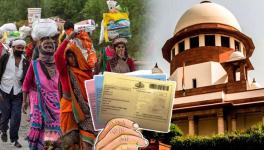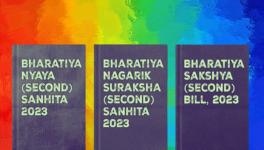Better Lunch to More Children at Lower Cost? Mystery of Mid-Day Meals
Representational use only.Image Courtesy: Flickr
Common sense tells us if you want to give better food to more people, you must spend more. However, the government of India appears to think otherwise. Between 2014 and 2021, it promised to extend and improve the mid-day meal scheme for schoolchildren, but in real terms, after accounting for inflation, the budget for mid-day meals decreased by almost a third, 32.3% to be precise.
About a year back, the government presented a more attractive-looking version of the mid-day meal scheme, which it grandly called the National Scheme for PM Poshan. It calls for extending school meals to more children and making special efforts to improve their nutrition content. The focus was on healthier food in so-called aspirational districts and other areas with a greater need—all very well, except it is all to be accomplished without budget hikes.
A consolidated budget for five years was announced last year—Rs. 54,061 crore—which works out to Rs. 10,812 crore per year. Now compare this to the allocation of Rs. 11,500 crore for mid-day meals in the budget estimate for 2021-22. Here we have again a government that seeks to do more and better by lowering how much it spends in actual terms. As it is, the government brought down the revised estimate of funds available for mid-day meals this year to Rs. 10,234 crore. This figure remains in the Budget Estimate for 2022-23. In 2014-15, the actual expenditure was Rs. 10,529 crore, slightly higher than the allocation made six years later.
Now compare this against recent reports that children were fed plain rice in a primary school in Deoria, where children complained about the insufficient quantity and poor quality of food. In fact, students, teachers and principals have been raising this issue across the country, especially in the poorest states. Now if we try to project the government’s expenditure plan for this scheme for up to 2025-26 (based on 2014-15 figures), this eleven-year period will significantly reduce the budget. In that case, will the quality of food served improve or worsen?
Of course, promises are always made that mid-day meals will be improved and extended. Forget modification to the current menu for a moment. Forget also the so-called plans to extend mid-day meals to more students. In the eleven years from 2014 to 2026, the number of students who enrol in government schools, which provide school lunches, is bound to increase. This increase was evident during and after the COVID-19 pandemic and lockdown-related disruption of livelihoods. At the time, many children who studied in private schools shifted to public schooling. That is another reason for a rise in government school enrolment despite the significant fall in public school enrolment over previous decades.
Another aspect of the mid-day meal budget is that the Rs. 12,878 crore expenditure in 2020-21, the COVID-19 year, was higher than in usual years. It happened, although schools remained shut for a substantial part of this year. Even when schools opened at some places, mid-day meals did not start for some time. Of course, the government gave directions to provide rations at students’ homes after some time. But it was a direction implemented in part, not in full. Even if schools provided dry rations, the expenses of buying vegetables, cooking oil, spices, milk, fuel and the cooks’ salaries were still not paid when schools remained closed. So it is unclear why expenditure shot up than in most normal years.
The New Education Policy recommends providing an additional Rs. 4,000 crore to include breakfast in school meals. According to reports, it has been rejected by the Ministry of Finance, which cited a funds constraint. Recall also that the nutrition standards of Indian children declined significantly in the years between 2015 and 2019.
As a result of the overall fund constraint, difficulties are being faced in ensuring food quality. Mid-day meal cooks suffer from particularly severe injustice. Of the nearly two million cooks, 90% are women, most from economically weaker sections or doubly vulnerable because they support themselves or their families alone. They have been working at shockingly low wages, to which the Union government contributes just about Rs. 1,000 per cook per month. If the state government contributes about Rs. 500, as happens in some states, the monthly salary is a paltry Rs. 1,500. A few state governments contribute more, but wages are meagre almost everywhere. It does not compare with the legal minimum wage or the cook’s work.
When this author contacted around 20 mid-day meal cooks in the remote villages of Bihar and Uttar Pradesh, they said their work begins at about 9 am, cleaning the kitchen. Many schools do not have sanitation workers, so teachers often ask the cook to clean other rooms. A cook and helper (where there is one) start cooking for about 70 children in the morning, then serve them, clean the utensils and arrange them. They finish by around 3 pm. Hence they work for almost six hours daily, although this changes depending on whether they make rice or rotis and other factors.
The cooks must work regardless of the weather or other difficulties and may not live close to the premises. Worse, their salaries are not paid regularly. Sometimes, the payment may come once in six months, when it may still be incomplete. One cook told me she got her wages only once in eight months and then for three-and-a-half months instead of the entire time she had worked.
Recent reports from Uttar Pradesh indicate many cooks have not been paid for five months. In a situation of severe fund constraints, the salaries of these vulnerable workers are likely to be the first casualty. What the two million cooks go through is perhaps an extreme instance of exploitation by the government. Most of them need an immediate four-fold increase in their monthly salaries and arrangements for prompt payment.
Remember that the mid-day meal scheme sought to improve school enrolment and attendance. It covers around 12 lakh schools and serves 12 crore students fresh cooked meals at school daily. The history of this scheme lies in a long struggle to implement the right to food as a fundamental right of all Indians. That is why it must provide better nutrition, hygienic kitchens and minimum wages to everyone working to make the project possible.
The writer is honorary convener, Campaign to Save Earth Now. His recent books include Protecting Earth for Children and India’s Quest for Sustainable Farming and Healthy Food. The views are personal.
Get the latest reports & analysis with people's perspective on Protests, movements & deep analytical videos, discussions of the current affairs in your Telegram app. Subscribe to NewsClick's Telegram channel & get Real-Time updates on stories, as they get published on our website.
























